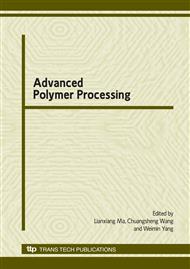p.154
p.160
p.167
p.172
p.177
p.183
p.188
p.194
p.200
3D Finite Element Simulation of Transient Temperature Field for Rapid Electrical Heating Cycle Injection Mold
Abstract:
Rapid electrical heating cycle injection molding technology can be used to produce polymer parts with no weld mark, flow mark and other surface defects on the parts surface. Recently, it has been gradually found wide use in plastic injection industry. In this paper, a structure of the rapid electrical heating cycle injection mold and its working processes were presented. As the production efficiency and the part’s quality are seriously affected by the temperature of the mold cavity surface and its distribution uniformity, the heat transfer process of the mold was analyzed by using 3D finite element simulation. The transient temperature values on different places of the cavity surface were obtained. The results provided theoretical guidelines for the engineers to evaluate the layout of the heating rods in the mold.
Info:
Periodical:
Pages:
177-182
Citation:
Online since:
December 2009
Authors:
Price:
Сopyright:
© 2010 Trans Tech Publications Ltd. All Rights Reserved
Share:
Citation:


